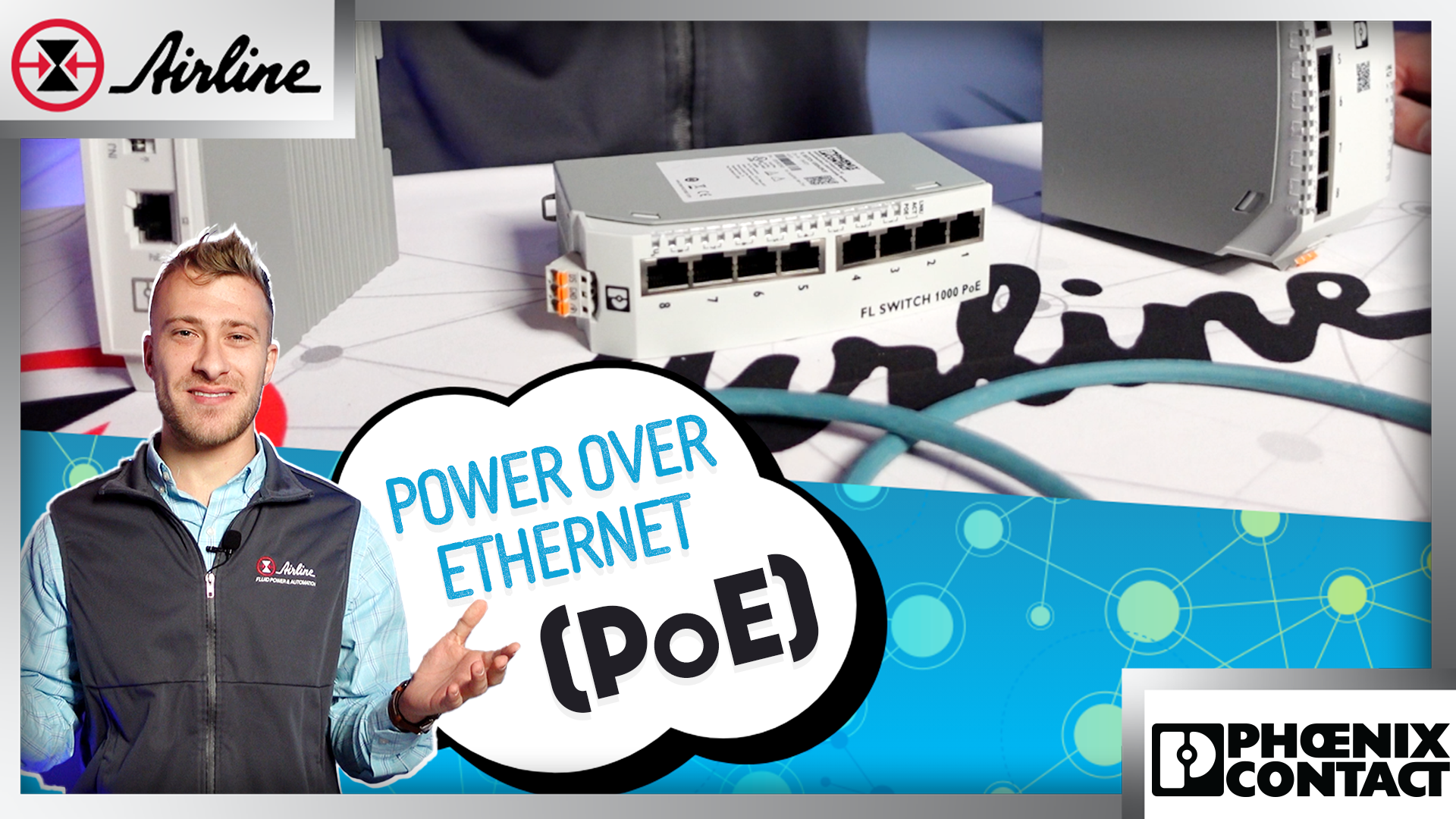Tired of dealing with messy cables and complex installations?
Imagine setting up your networking devices—like security cameras, sensors, or wireless access points—without needing separate power sources or an additional power cable. That’s the magic of Power over Ethernet (PoE).
PoE simplifies installations by delivering both power and data over a single Ethernet cable, cutting down on extra wiring, reducing costs, and making your setup more flexible and reliable.
But how does it work, and why is it becoming the go-to solution for industrial and commercial applications? Let’s break it down—plus, we’ll explore the latest advancements, including Phoenix Contact’s upgraded PoE switches.
In This Post
What is Power over Ethernet (PoE)? | How Does PoE Work? | Why Use Power over Ethernet? | Key Components in PoE Systems | PoE vs. Traditional Power Methods | Phoenix Contact’s Latest PoE Solutions | The Evolution of PoE Standards | Is PoE Right for Your Application? | Why PoE is the Future of Networked Power | Frequently Asked Questions about PoE
💡 Thinking about upgrading to PoE for your facility?
Explore our selection of PoE switches and solutions TODAY!
Key Takeaways✔️ Power over Ethernet (PoE) simplifies installations and cable clutter by combining power and data transmission over a single Ethernet cable, reducing clutter and installation costs. ✔️ PoE technology enhances network flexibility and efficiency by enabling device placement in remote locations that can be connected to the central control using only a single ethernet cable. |
What is Power over Ethernet (PoE)?
Power over Ethernet (PoE) is a technology that delivers DC power over standard Ethernet cables, eliminating the need for a separate cable or additional power source. This enables devices such as security cameras, sensors, and wireless access points to receive both power and data from a single cable.
How Does PoE Work?
PoE functions by using a PoE injector or a PoE switch to introduce power into the Ethernet cable. That cable then transmits both power and data to the connected device—without requiring additional power cabling.
This approach reduces installation complexity and cost, making it a preferred choice for industrial automation, building management systems, and security applications.
Want a quick visual breakdown of how PoE works? Check out our video to see it in action!
Have questions about integrating PoE into your setup? Contact us today to learn more!
Why Use Power over Ethernet?
Now that we’ve covered how PoE works, let’s dive into why so many businesses and industries are adopting this technology. From cost savings to improved reliability, PoE simplifies installation while delivering better flexibility, safety, and scalability for modern networked systems.
✔️ Saves Time & Lowers Installation Costs:
Traditional remote sensor or camera placement requires an ethernet connection and power using separate cables. PoE eliminates the need for separate power cables or supplies, reducing labor costs and material expenses. Plus, because there is only one cable, a cable conduit to protect the different cables is not needed unless specified otherwise if using the correct IP-rated ethernet cable.
✔️ Increases Flexibility for Device Placement:
Since PoE-powered devices only require a single cable, they can be installed in optimal positions with only a single cable—whether that’s high ceilings, parking lots, or outdoor security posts. This makes them perfect for surveillance cameras, access points, digital displays, and IoT sensors. Plus, devices can be easily repositioned without significant electrical work.
✔️ Improves Safety & Prevents Electrical Hazards:
Unlike traditional AC power, PoE operates at low voltages (typically 24V or 48V DC), reducing the risk of electric shock or fire hazards. PoE-enabled power delivery also intelligently protects devices from overloading, underpowering, or incorrect installation, ensuring safe and stable operation.
✔️ Enhances Reliability with Centralized Power Management:
PoE provides power from a single, universally compatible source, eliminating the need for multiple cables or power sources. It can be backed up with an Uninterruptible Power Supply (UPS), ensuring continuous operation even during power failures—critical for security cameras, network infrastructure, and emergency systems.
✔️ Simplifies Scaling & Expanding Your Network:
With PoE, adding new devices is as simple as connecting an Ethernet cable. Whether you're expanding a factory floor, office network, or smart building, PoE streamlines device deployment without requiring additional electrical work. This makes it a cost-effective solution for growing operations that need reliable, easily managed power distribution.
Key Components in PoE Systems
PoE systems comprise several key components, including power sourcing equipment (PSE), powered devices (PD), and PoE injectors and extenders. Choosing the correct PoE equipment ensures compatibility with the power needs of your devices.
Think of PoE as a team effort—each component plays a role in making sure your devices get both power and data seamlessly. Let’s break down who does what in this system.
Power Sourcing Equipment (PSE)
 Power sourcing equipment, or PSE, supplies power to devices via Ethernet cables. A PoE injector or switch is crucial in a PoE system, powering connected devices and eliminating the need for an additional power source.
Power sourcing equipment, or PSE, supplies power to devices via Ethernet cables. A PoE injector or switch is crucial in a PoE system, powering connected devices and eliminating the need for an additional power source.
Traditional switches can’t supply power to end devices over Ethernet, requiring additional PSEs and power cables. Adhering to PoE standards, PSE ensures the compatibility and functionality of connected devices.
Powered Devices (PD)

Powered devices (PD) in a PoE system are network devices that are powered with PoE technology, receiving both power and data through a single cable. Common examples of powered devices include sensors, cameras, and wireless access points. PoE enables these devices to use a single cable for both power and data, simplifying installations.
Not sure which PoE equipment is needed?
Our team can help you choose the right components for your application!
Contact us TODAY!
PoE vs. Traditional Power Methods
PoE’s ability to reduce cable clutter, minimize costs, and simplify installation makes it a superior choice for modern industrial and commercial applications.
|
Feature |
PoE |
Traditional Power |
|
Cabling Requirements |
Single Ethernet cable for power & data |
Separate cables for power & data |
|
Installation Complexity |
Simple and cost-effective single ethernet cable |
Requires electrical wiring & supplies |
|
Flexibility |
Single cable allows for flexible location |
Limited to multiple cables and/or power sources |
|
Cost Efficiency |
Lower installation & maintenance costs |
Higher costs for power infrastructure |
|
Scalability |
Easily expandable |
Requires additional electrical work |
Phoenix Contact’s Latest PoE Solutions
Phoenix Contact has been a long-time leader in PoE technology, and they recently upgraded their PoE switch lineup to improve efficiency and adaptability.
What’s New in Phoenix Contact’s FL PoE Switch Line?
- Compact, modern design replacing older, bulkier models
- Up to 8 ports available (both managed and unmanaged options)
- PoE injectors for seamless integration of simple applications
These improvements provide better scalability, flexibility, and power efficiency for industrial and commercial applications.
🔍 Upgrade to the latest PoE technology with Phoenix Contact’s new FL Switch lineup. Get yours today! Shop Now
The Evolution of PoE Standards
PoE has evolved significantly since its inception, with increasing power capabilities supporting more advanced devices.
|
PoE Standard |
Year |
Max Power (per device) |
Common Applications |
|
IEEE 802.3af |
2003 |
15.4W |
IP Phones, Basic Cameras, Wireless Access Points |
|
IEEE 802.3at |
2009 |
25.5W |
Advanced Cameras, Access Control Systems, Industrial Sensors |
|
IEEE 802.3bt |
2018 |
60W |
LED Lighting, Kiosks, Monitors, Alarm Systems |
|
IEEE 802.3bt |
2018 |
90W |
USB-C Laptops, Smart Building Devices, Industrial Applications |
What’s New in PoE?
The latest IEEE 802.3bt PoE standard (Type 3 and Type 4) delivers up to 90W of power, allowing power-hungry devices such as laptops, LED lighting, air conditioning units, and even refrigerators to be powered over Ethernet.
With this advancement, smart buildings and industrial automation are seeing rapid adoption of PoE for integrated control systems, converging IT and OT (Operational Technology) networks.
Is PoE Right for Your Application?

PoE is ideal for industries requiring scalable, cost-effective, and reliable power solutions.
Common PoE Applications:
Industrial Automation – Sensors, controllers, and monitoring systems
Security & Surveillance – IP cameras, access control, and alarm systems
Smart Buildings – LED lighting, occupancy sensors, HVAC systems
Retail & Kiosks – Digital signage, interactive displays, self-service kiosks
Enterprise Networking – Wireless access points, VoIP phones, conference room tech
Need help determining if PoE is the right choice for your setup? Let’s talk - Contact us TODAY!
Why PoE is the Future of Networked Power
As technology advances, Power over Ethernet is playing a crucial role in smart infrastructure, automation, and connectivity. With higher power capabilities, better efficiency, and improved device compatibility, PoE is revolutionizing how businesses deploy technology—saving time, money, and resources.
Next Steps:🚀 Power your network with Phoenix Contact’s latest PoE switches - explore our products to find the best solution for your needs. 📞 Contact us for expert guidance or installation support. |
Frequently Asked Questions about PoE
What is the difference between Ethernet and PoE?
The key difference between Ethernet and PoE is that PoE (Power over Ethernet) allows devices to receive both power and data through a single Ethernet cable, while standard Ethernet cables only transmit data. Thus, PoE simplifies wiring by eliminating the need for separate power sources for compatible devices.
What is the meaning of PoE?
The meaning of PoE is Power over Ethernet, which allows network cables to carry electrical power along with data. This technology simplifies installation and reduces the need for additional power sources.
What is a PoE used for?
PoE is used to deliver electrical power along with data to devices like sensors, cameras, and wireless access points over standard Ethernet cables. This technology streamlines installations by eliminating the need for separate power supplies.
What is Power over Ethernet (PoE)?
Power over Ethernet (PoE) is a technology that enables both power and data to be delivered through a single Ethernet cable, streamlining installations and minimizing the need for additional power sources.
What are the benefits of using PoE?
Using Power over Ethernet (PoE) can greatly enhance your setup by providing cost savings, installation flexibility, and minimizing cable clutter through the combination of power and data transmission over a single Ethernet cable. This efficiency can streamline your operations and reduce the complexity of your network infrastructure.







Leave Comment